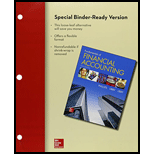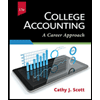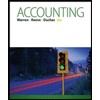
Loose-leaf for Fundamentals of Financial Accounting with Connect
5th Edition
ISBN: 9781259619007
Author: Fred Phillips Associate Professor
Publisher: McGraw-Hill Education
expand_more
expand_more
format_list_bulleted
Question
Chapter 3, Problem 13Q
To determine
To explain: Which of the four basic accounting reports indicates that it is appropriate to consider revenues and expense as categories of
Expert Solution & Answer
Want to see the full answer?
Check out a sample textbook solution
Students have asked these similar questions
Please show me the correct approach to solving this financial accounting question with proper techniques.
Can you solve this accounting question with accurate accounting calculations?
Can you solve this general accounting question with the appropriate accounting analysis techniques?
Chapter 3 Solutions
Loose-leaf for Fundamentals of Financial Accounting with Connect
Ch. 3 - Prob. 1QCh. 3 - When accounting was developed in the 14th and 15th...Ch. 3 - Define accrual basis accounting and contrast it...Ch. 3 - Prob. 4QCh. 3 - Prob. 5QCh. 3 - Prob. 6QCh. 3 - Explain the expense recognition principle...Ch. 3 - Explain why stockholders equity is increased by...Ch. 3 - Explain why revenues are recorded as credits and...Ch. 3 - Complete the following table by entering either...
Ch. 3 - Complete the following table by entering either...Ch. 3 - Prob. 12QCh. 3 - Prob. 13QCh. 3 - What is the difference between Accounts Receivable...Ch. 3 - What is the difference between Accounts Payable...Ch. 3 - For each of the following situations, indicate...Ch. 3 - Prob. 17QCh. 3 - Which of the following items is not a specific...Ch. 3 - Prob. 2MCCh. 3 - Prob. 3MCCh. 3 - Prob. 4MCCh. 3 - If a company incorrectly records a payment as an...Ch. 3 - Prob. 6MCCh. 3 - Prob. 7MCCh. 3 - Prob. 8MCCh. 3 - Webby Corporation reported the following amounts...Ch. 3 - Prob. 10MCCh. 3 - Prob. 3.1MECh. 3 - Identifying Accrual Basis Revenues The following...Ch. 3 - Identifying Accrual Basis Expenses The following...Ch. 3 - Recording Accrual Basis Revenues For each of the...Ch. 3 - Recording Accrual Basis Expenses For each of the...Ch. 3 - Prob. 3.6MECh. 3 - Prob. 3.7MECh. 3 - Prob. 3.8MECh. 3 - Prob. 3.9MECh. 3 - Identifying Accrual Basis Expenses The following...Ch. 3 - Prob. 3.11MECh. 3 - Recording Accrual Basis Expenses For each of the...Ch. 3 - Prob. 3.13MECh. 3 - Preparing Accrual Basis Journal Entries for...Ch. 3 - Preparing Accrual Basis Journal Entries for...Ch. 3 - Prob. 3.16MECh. 3 - Determining the Accounting Equation Effects of...Ch. 3 - Prob. 3.18MECh. 3 - Preparing an Income Statement and Calculating Net...Ch. 3 - Preparing Financial Statements from a Trial...Ch. 3 - Preparing an Income Statement and Calculating Net...Ch. 3 - Prob. 3.22MECh. 3 - Calculating and Interpreting Net Profit Margin...Ch. 3 - Prob. 3.1ECh. 3 - Matching Definitions with Terms Match each...Ch. 3 - Identifying Accrual Basis Revenues According to...Ch. 3 - Identifying Accrual Basis Revenues According to...Ch. 3 - Identifying Accrual Basis Expenses Under accrual...Ch. 3 - Identifying Accrual Basis Expenses Under accrual...Ch. 3 - Determining Accounting Equation Effects and Net...Ch. 3 - Determining Accounting Equation Effects and Net...Ch. 3 - Recording Journal Entries and Determining Net...Ch. 3 - Prob. 3.10ECh. 3 - Recording Journal Entries and Determining Net...Ch. 3 - Recording and Posting Accrual Basis Journal...Ch. 3 - Prob. 3.13ECh. 3 - Analyzing Transactions from the Perspectives of...Ch. 3 - Prob. 3.15ECh. 3 - Determining Accounting Equation Effects of Several...Ch. 3 - Preparing Journal Entries For each of the...Ch. 3 - Prob. 3.18ECh. 3 - Creating an Unadjusted Trial Balance Based on the...Ch. 3 - Inferring Transactions, Creating Financial...Ch. 3 - Determining the Effects of Various Transactions EZ...Ch. 3 - COACHED PROBLEMS Recording Nonquantitative Journal...Ch. 3 - Prob. 3.2CPCh. 3 - Prob. 3.3CPCh. 3 - Prob. 3.4CPCh. 3 - Prob. 3.1PACh. 3 - Recording Journal Entries Diana Mark is the...Ch. 3 - Analyzing the Effects of Transactions Using...Ch. 3 - Prob. 3.4PACh. 3 - Prob. 3.1PBCh. 3 - Prob. 3.2PBCh. 3 - Analyzing the Effects of Transactions Using...Ch. 3 - Analyzing, Journalizing, and Interpreting Business...Ch. 3 - Prob. 3.1COPCh. 3 - SKIL_S DEVELOPMENT CASES Finding Financial...Ch. 3 - Prob. 3.2SDCCh. 3 - Prob. 3.4SDCCh. 3 - Ethical Decision Making: A Mini-Case Mike Lynch is...Ch. 3 - Accounting for Business Operations Starting in...
Knowledge Booster
Similar questions
- Can you solve this general accounting question with the appropriate accounting analysis techniques?arrow_forwardPlease provide the accurate answer to this general accounting problem using valid techniques.arrow_forwardI need guidance on solving this financial accounting problem with appropriate financial standards.arrow_forward
arrow_back_ios
SEE MORE QUESTIONS
arrow_forward_ios
Recommended textbooks for you
 College Accounting (Book Only): A Career ApproachAccountingISBN:9781337280570Author:Scott, Cathy J.Publisher:South-Western College PubPrinciples of Accounting Volume 1AccountingISBN:9781947172685Author:OpenStaxPublisher:OpenStax College
College Accounting (Book Only): A Career ApproachAccountingISBN:9781337280570Author:Scott, Cathy J.Publisher:South-Western College PubPrinciples of Accounting Volume 1AccountingISBN:9781947172685Author:OpenStaxPublisher:OpenStax College Intermediate Accounting: Reporting And AnalysisAccountingISBN:9781337788281Author:James M. Wahlen, Jefferson P. Jones, Donald PagachPublisher:Cengage Learning
Intermediate Accounting: Reporting And AnalysisAccountingISBN:9781337788281Author:James M. Wahlen, Jefferson P. Jones, Donald PagachPublisher:Cengage Learning Accounting (Text Only)AccountingISBN:9781285743615Author:Carl Warren, James M. Reeve, Jonathan DuchacPublisher:Cengage Learning
Accounting (Text Only)AccountingISBN:9781285743615Author:Carl Warren, James M. Reeve, Jonathan DuchacPublisher:Cengage Learning Cornerstones of Financial AccountingAccountingISBN:9781337690881Author:Jay Rich, Jeff JonesPublisher:Cengage Learning
Cornerstones of Financial AccountingAccountingISBN:9781337690881Author:Jay Rich, Jeff JonesPublisher:Cengage Learning Managerial AccountingAccountingISBN:9781337912020Author:Carl Warren, Ph.d. Cma William B. TaylerPublisher:South-Western College Pub
Managerial AccountingAccountingISBN:9781337912020Author:Carl Warren, Ph.d. Cma William B. TaylerPublisher:South-Western College Pub

College Accounting (Book Only): A Career Approach
Accounting
ISBN:9781337280570
Author:Scott, Cathy J.
Publisher:South-Western College Pub

Principles of Accounting Volume 1
Accounting
ISBN:9781947172685
Author:OpenStax
Publisher:OpenStax College

Intermediate Accounting: Reporting And Analysis
Accounting
ISBN:9781337788281
Author:James M. Wahlen, Jefferson P. Jones, Donald Pagach
Publisher:Cengage Learning

Accounting (Text Only)
Accounting
ISBN:9781285743615
Author:Carl Warren, James M. Reeve, Jonathan Duchac
Publisher:Cengage Learning

Cornerstones of Financial Accounting
Accounting
ISBN:9781337690881
Author:Jay Rich, Jeff Jones
Publisher:Cengage Learning

Managerial Accounting
Accounting
ISBN:9781337912020
Author:Carl Warren, Ph.d. Cma William B. Tayler
Publisher:South-Western College Pub